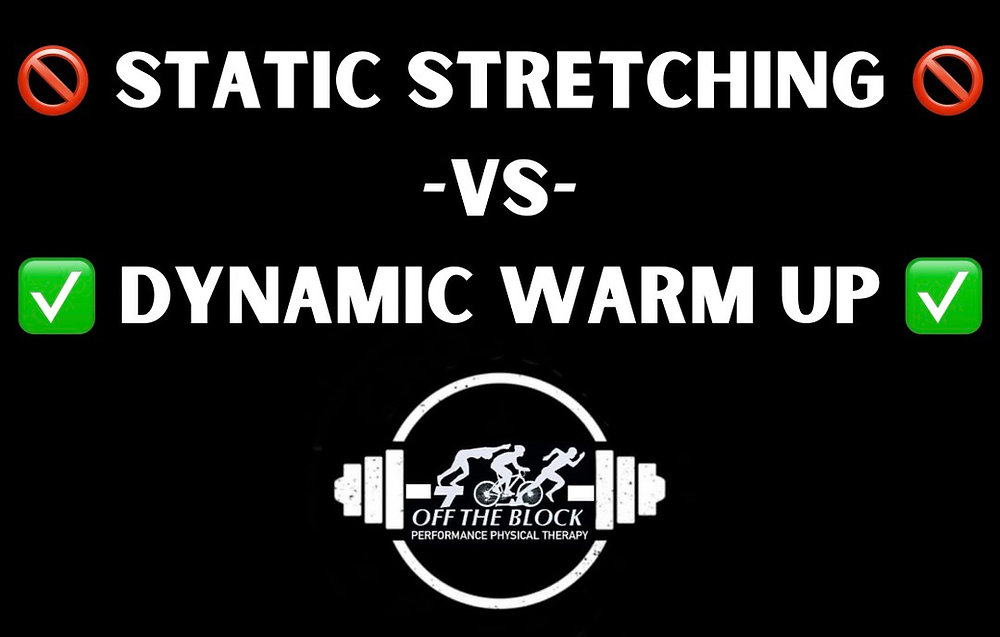
Many of you in the fitness world may have begun to hear, in the past few years, about the differences in the outcomes of static stretching sessions versus a dynamic warm-up. But with this excess of fitness/medical jargon, you may still be unsure of the benefits or differences between the two. The teachings are showing that the “old school” style of static stretching, (basically holding stretches for an arbitrary amount of time, often 15-second holds) are not as good as a dynamic warm-up. But what are they not as good at? Does It really depend on what your goals are? In recent years, some of the new research that has been done to determine if static or dynamic stretching have any true benefit has produced results that may be surprising.
WHAT ARE STATIC AND DYNAMIC STRETCHING?
Dynamic stretching is a warm up movement strategy used to improve mobility while moving through a specific range-of- motion, often in a manner that looks similar to the activity that is going to be performed. Static stretching is holding a position at the end range of the available range of motion without movement, for a predetermined period of time.
STATIC VERSUS DYNAMIC STRETCHING: CURRENT CONCEPTS
For years now, the most recent research has shown that static stretching may actually decrease performance! The results of static stretching have been shown to decreased sprint times in runners, limit the height of jumps in basketball and volley ball players, lessen agility in soccer players, and reduce force-production in both elite women and men athletes. In contrast, dynamically warming up, and the mobility achieved afterwards, shows benefits in production of speed, power, and agility. More importantly, dynamic stretching has been proven to actually decrease risk of injury in both recreational and elite athletes, due to the similarities of the motions performed in warm up, and the positions in which high velocity force are applied to an athletes body that often lead to injury. If these positions and body parts have already been prepared to accommodate for a higher amount of load, they know how to respond properly, instead of simply allowing damage to occur.
Researchers believe that static stretching has no direct long-term negative affects on an athletes body; however this form of stretching will temporarily (but significantly) decrease the ability of a muscle to produce high levels of force and This places an athlete’s body at risk of injury by decreasing the athletes ability to control motion. This lack of control can lead to damage of ligaments and muscles, which are Obviously unwanted issues. In fact, most often, these are the issues that people are trying to avoid by performing their stretches.
Dynamic stretching, on the other hand, has been shown to significantly increase the ability of a muscle to produce a stabilizing force. This has huge positive implications for athletes, as dynamic stretching can improve an athletes bodies stabilizing performance throughout a muscle’s entire range-of- motion. This effect can protect the body’s joints and soft tissues during activity and actually prevent injuries that could have occurred following a static stretching routine.
HOW TO PERFORM DYNAMIC STRETCHES
Since dynamic stretching is a little different for most people, depending on the level of performance, and the individual limitations of the athlete, it is recommended that individuals seek some training in how best to perform dynamic stretches instead of starting a cookie cutter one size fits all dynamic movement routine. It is particularly beneficial to seek a Licensed Doctor of Physical Therapy who is trained in current concepts of dynamic stretching, like those at OFF THE BLOCK Performance Physical Therapy. Our therapist is educated in the most current form of physical therapy that looks at an individual’s functional needs and she can design an individualized dynamic stretching program to directly benefit that athlete. The needs of a swimmer will drastically differ from the needs of a CrossFitter, weightlifter, runner or soccer player.
In order to perform dynamic stretching, a person usually moves smoothly into, and out of, a stretch. They hold the end-range for just a few seconds and then take the joint through all of its range-of- motion. For some examples of how to perform dynamic stretches VS static stretches, take a look at this video linked below!
If you’re interested in having a doctor of physical therapy evaluate your mobility and make recommendations for individualized training, or if you’re dealing with pain and are interested in a full diagnostic evaluation to begin to address your pain from the root cause of the problem today or if you have questions, please DM or Contact us!
📧 offtheblockpt@Gmail.com
☎️ 864-561-5493
💪🏼Our three step process to your recovery💪🏼
We use a personalized 1:1 approach to:
1. Relieve your pain
2. Identity and address the underlying root causes
3. Give you tools to stay pain free long term
✨ We also offer virtual consults/ treatments and injury prevention programming ✨
📲 DM for more info
.png?width=1280&height=720&name=Untitled%20design%20(22).png)



